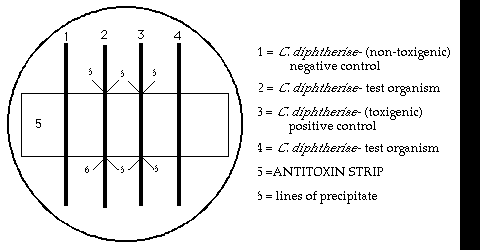

The elaboration of exotoxins plays a major role in the pathogenesis of several groups of Gram-positive bacilli. The corynebacteria, clostridia, and bacilli vary greatly in other parameters such as metabolism, sporulation, epidemiology and the target organ for infection, but they share the ability to produce severe disseminated disease by releasing toxin from a relatively localized infection.
The corynebacteria are Gram-positive, slender bacilli, frequently curved or club- shaped and sometimes showing branching and filamentous forms.
Corynebacterium diphtheriae is the sole member primarily pathogenic for man by virtue of its capacity to produce diphtherial exotoxin. Diphtherial exotoxin is elaborated by the organism at the primary site of infection, from which it diffuses through the body to cause such complications as diphtheritic carditis, and peripheral neuritis. Humans are the only significant reservoir for C. diphtheriae.
Different strains of C. diphtheriae vary in their ability to produce exotoxin; only lysogenic C. diphtheriae produce diphtherial exotoxin. Other corynebacteria, so- called diphtheroids, are found among the normal commensal flora of the nose, throat, conjunctiva and vagina. These frequently are found as contaminants in endodontic infections.
The clostridia are Gram-positive sporulating bacilli, all of which are obligate anaerobes, although their sensitivity to oxygen varies considerably from species to species. Because of their anaerobic metabolism, the clostridia germinate and multiply only under narrowly defined environmental conditions consisting primarily of those with a lowered oxidation-reduction potential such as exists in tissues devitalized by trauma or in air-tight food containers.
A few species of Clostridium are considered pathogenic because they are capable of producing potent exotoxins. The clinical symptoms of clostridial diseases in man and animals, regardless of the type (tetanus, gas gangrene, botulism) are the result of toxemia not infection.
The most potent of all clostridial exotoxins is produced by Clostridium botulinum. As contaminants of incompletely sterilized canned foods, Clostridium botulinum spores germinate when suitable anaerobic conditions exist, and produce their exotoxin. Botulism results when the exotoxin in the food is ingested.
Clostridium tetani elaborates a potent neurotoxin at the site of bacterial replication, usually in a wound contaminated with fecal material. Clostridium perfringens, another wound contaminant, elaborates a lethal, hemolytic, necrotizing exotoxin. C. perfringens is a universal inhabitant of the lower intestinal tract and occasionally the vagina; hence its frequent implication in cases of septic abortion.
The aerobic bacilli comprise a large group of sporulating, Gram-positive organisms widely distributed in nature. Only one member of the genus Bacillus (Bacillus anthracis, the anthrax bacillus) is consistently pathogenic for man and animal.
This group of microorganisms is the source of at least two widely used polypeptide antibiotics, namely bacitracin, from Bacillus subtilis and polymyxin, from Bacillus polymyxa.
Spores produced by these organisms have marked resistance to heat and other deleterious agents. Materials to be sterilized must therefore be heated to levels certain to exceed temperatures lethal to the bacterial spores. This is usually accomplished with steam under pressure (autoclaving).
Tinsdale agar is a selective medium for corynebacterial species. Much of the normal flora of the upper respiratory tract is inhibited by the concentration of potassium tellurite in the medium, while the corynebacteria grow well as brown-black colonies. In addition, colonies of C. diphtheriae produce a brownish-black fuzziness or "halo" in the agar immediately surrounding the colony. C. xerosis (a diphtheroid) does not produce this halo.
| Organism | Tinsdale Agar |
|---|---|
| Corynebacterium diphtheriae | Small, brownish-black colonies surrounded by a BROWN HALO in the agar |
| Other diphtherial species Diphtheroids Corynebacterium xerosis | Small, brownish-black colonies - NO HALO in surrounding agar |
A strip of filter paper containing antibody to diphtheria toxin is incorporated into a TSA plate. The strain of C. diphtheriae to be tested is inoculated in a heavy straight line at right angles to the antitoxin strip. Positive and negative control organisms are also streaked at right angles to the strip.
The unknown C. diphtheriae strain is identified as toxigenic if a line of immunoprecipitation on both sides of the inoculated bacterial line is observed. (See diagram next page.) Note that the diagram and photograph may NOT show the same results. Do not report the results from this diagram.

